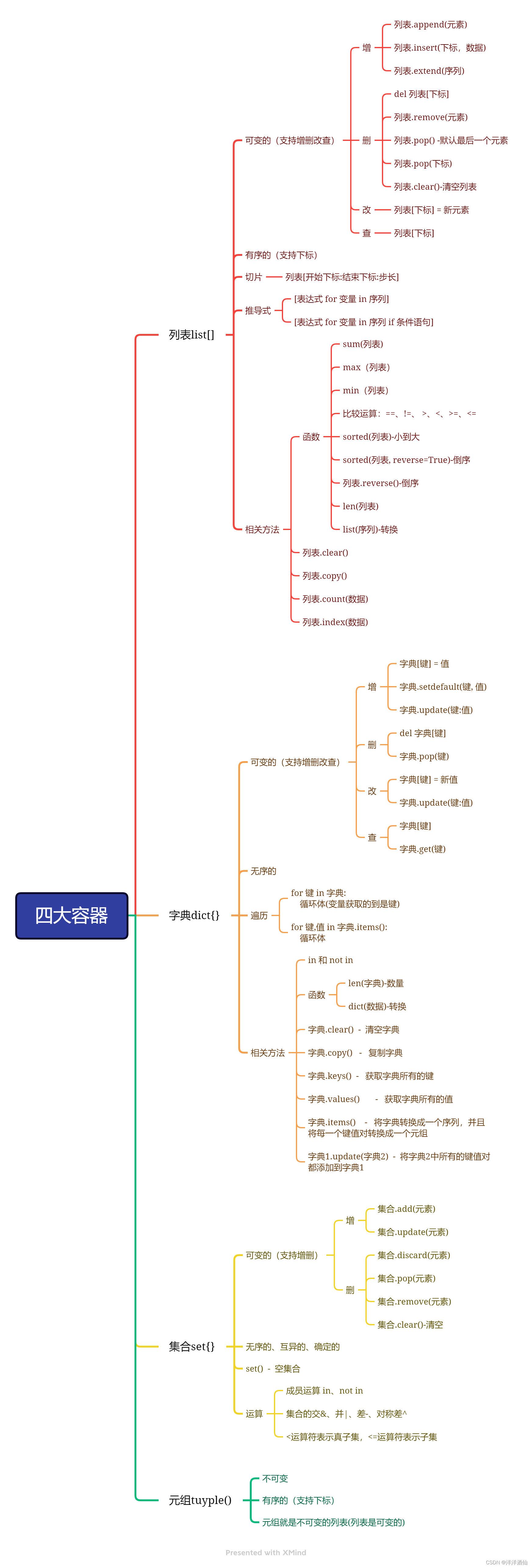-
编写一个程序,交换指定字典的key和value。
dict1 = {'a': 1, 'b': 2, 'c': 3} new_dict1 = {j:i for i,j in dict1.items()} print(new_dict1) -
编写一个程序,提取指定字符串中所有的字母,然后拼接在一起产生一个新的字符串
str1 = '12a&bc12d-+' new_str1 = '' for i in str1: if 'a'<=i<='z' or 'A'<=i<='Z': new_str1 += i print(new_str1) -
写一个自己的capitalize函数,能够将指定字符串的首字母变成大写字母
str1 = 'abc'
first_char = str1[0]
if first_char.islower():
new_str = first_char.upper() + str1[1:]
else:
new_str = first_char + str1[1:]
print(new_str)
- 写程序实现endswith的功能,判断一个字符串是否已指定的字符串结束
str1 = 'abc231ab'
str2 = 'ab'
if str1[-len(str2):] == str2:
print(True)
else:
print(False)
- 写程序实现isdigit的功能,判断一个字符串是否是纯数字字符串
str1 = '1234921'
for x in str1:
if not x.isdigit():
print(False)
break
else:
print(True)
- 写程序实现upper的功能,将一个字符串中所有的小写字母变成大写字母
str1 = 'abH23好rp1'
new_str1 = ''
for x in str1:
if 'a' <= x <= 'z':
new_str1 += chr(ord(x)- 32)
else:
new_str1 += x
print(new_str1)
- 写程序获取指定序列中元素的最大值。如果序列是字典,取字典值的最大值
str7 = {'小明': 90, '张三': 76, '路飞': 30, '小花': 98}
list1 = []
if type(str7) != dict:
for i in str7:
print(type(i))
if type(i) == int or type(i) == float:
list1.append(i)
elif 'a'<=str(i)<='z' or 'A'<=str(i)<='Z':
list1.append(ord(i))
if max(list1) == i or max(list1) ==ord(i):
print(i)
else:
list2=[]
for key in str7:
list2.append(str7[key])
print(max(list2))
- 写程序实现replace函数的功能,将指定字符串中指定的旧字符串转换成指定的新字符串
# 方法1:
result = new.join(str1.split(old))
print(result)
# 方法2(自己写逻辑):
index = 0
new_str = ''
len1 = len(str1)
len_old = len(old)
while True:
if str1[index: index+len_old] == old:
new_str += new
index += len_old
else:
new_str += str1[index]
index += 1
if index >= len1:
break
print(new_str)
- 写程序实现split的功能,将字符串中指定子串作为切割点对字符串进行切割
str1 = 'how are you? and you?'
str2 = 'you'
result = []
item = ''
index = 0
len1 = len(str1)
len2 = len(str2)
while True:
if str1[index: index+len2] == str2:
result.append(item)
item = ''
index += len2
else:
item += str1[index]
index += 1
if index >= len1:
break
result.append(item)
print(result)
10.四大元组的思维导图

列表基础练习题
选择题
-
下列选项中能正确表示一个列表的是()。
A.
{1, 2, 3}B.
[10, abc, 123]C.
[10 20 30]D.
[1, 2, 3]解释:D A是集合,B中abc不是字符串,C啥也不是
-
(多选)已知一个列表
nums = [10, 20, '小明', [1, 2]],以下表达式结果是小明的是?()A.
nums[-3]B.
nums[3]C.
nums[-2]D.
nums[2]解释:D 下标为0,1,2,3 or -4,-3,-2,-1对应的为10,20,‘小明’,[1,2]
-
以下选项关于列表说法错误的是?()
A. 列表可以放在
for循环的in后面B. 列表是可变的序列
C. 列表是有序的,只支持增删改,不支持查操作
D. 列表的
in操作可以判断元素是否存在解释:C 列表是可变的有序的,支持增删改查操作,支持下标操作
-
已知一个列表
names = ['小乔', '甄姬', '王昭君', '妲己', '女娲', '西施', '嬴政'],下面的表达式中结果是[]的是?()A. names[1:]
B. names[:1]
C. names[1:4:-1]
D. names[1:4:2]
解释:C 开始下标大于结束下标才能用负号
-
已知列表
list1 = [10, [1, 2], 100, 1000],下列表达式结果是True的是?()A.
100 not in list1B.
1 in list1C.
2 in list1D.
[1, 2] in list1解释:D A是False,100在序列中;B、C是在序列中的序列中
-
下列选项中不属于序列的是?()
A. []
B. ‘100’
C. {1, 2}
D. 100
解释:D A是列表,B是字符串,C是集合
-
已知
student = {'name': '小明', 'age': 18, 'gender':'男'}下列关于字典的操作正确的是?()A.
student('name')B.
student[name]C.
student['小明']D.
student['age']解释:D
-
下列表达式有误的是?()
A.
100 + 30.03B.
188 * '12'C.
188 * 12D.
188 + '12'解释:D 数字不能和字符串相加减
-
(多选)下列表达式能产生
[1, 2, 3]的是?()A.
[1, 2] + [3]B.
[1, 2].append(3)C.
[1, 2].extend(3)D.
[1, 2, 3] * 1解释:AD B返回值为None,C报错
-
(多选)下列选项中属于可变序列的是?()
A. 列表
B. 元组
C. 字典
D. 字符串
解释:AC 数据类型中只有列表、集合、字典可变,其它不可变
填空题
- python中获取指定数据的类型可以使用( type() )函数。
- 查看数据地址的函数是( id )。
- 如果要将数据转换成列表,需要使用( list() )。
- ( count() )函数可以用来获取任意序列中元素的个数。
- 如果需要将一个数据插入到列表的中间需要使用函数( insert )。
- Python中数学集合运算中求交集、并集、差集和对称差集的符号分别是( & )、( | )、( - )、( ^ )。
- 请列举出你知道的Python中的不可变的数据类型:(整型、浮点型、布尔、字符串、元组)。
- 获取字符编码值和获取编码值对应的字符的函数分别是( chr(编码值) )、( ord(字符) )。
- 如果要判断序列中是否存在某个元素可以使用( in )来判断。
- 如果要判断两个数据的地址是否相等可以使用( == )。
编程题
-
已知一个列表
names = ['胡歌', '王凯', '王俊凯', '杨幂', '刘德华', '张国荣', '王祖贤', '张伟']。1)依次打印列表中的每个元素
for i in names: print(i)2)统计列表中姓
张的人的个数。count = 0 for i in names: if i[0] == '张': count += 1 print(count)3)统计名字是两个字的人的个数。
count = 0 for i in names: if len(i) == 2: count += 1 print(count) -
已知字典
dog = {'name': '大黄', 'color': 'yellow', 'age': 3, 'kind': '土狗'}1)打印所有key对应的值
key1 ={i for i in dog} print(key1)2)将name的值修改成 ‘旺财’
dog['name']='旺财' print(dog)3)添加狗的价格对应的键值对
dog['price']=1000 print(dog)4)清空dog字典
dog.clear() print(dog) -
已知字符串
message = 'You see see, one day day!'1)统计字符串中非字母的字符个数
count += 0 for i in message: if not i.isalpha(): count +=1 print(count)2)提取出所有的小写字母
str1 = '' for i in message: if i.islower(): str1 += i print(str1)





















 3080
3080











 被折叠的 条评论
为什么被折叠?
被折叠的 条评论
为什么被折叠?








